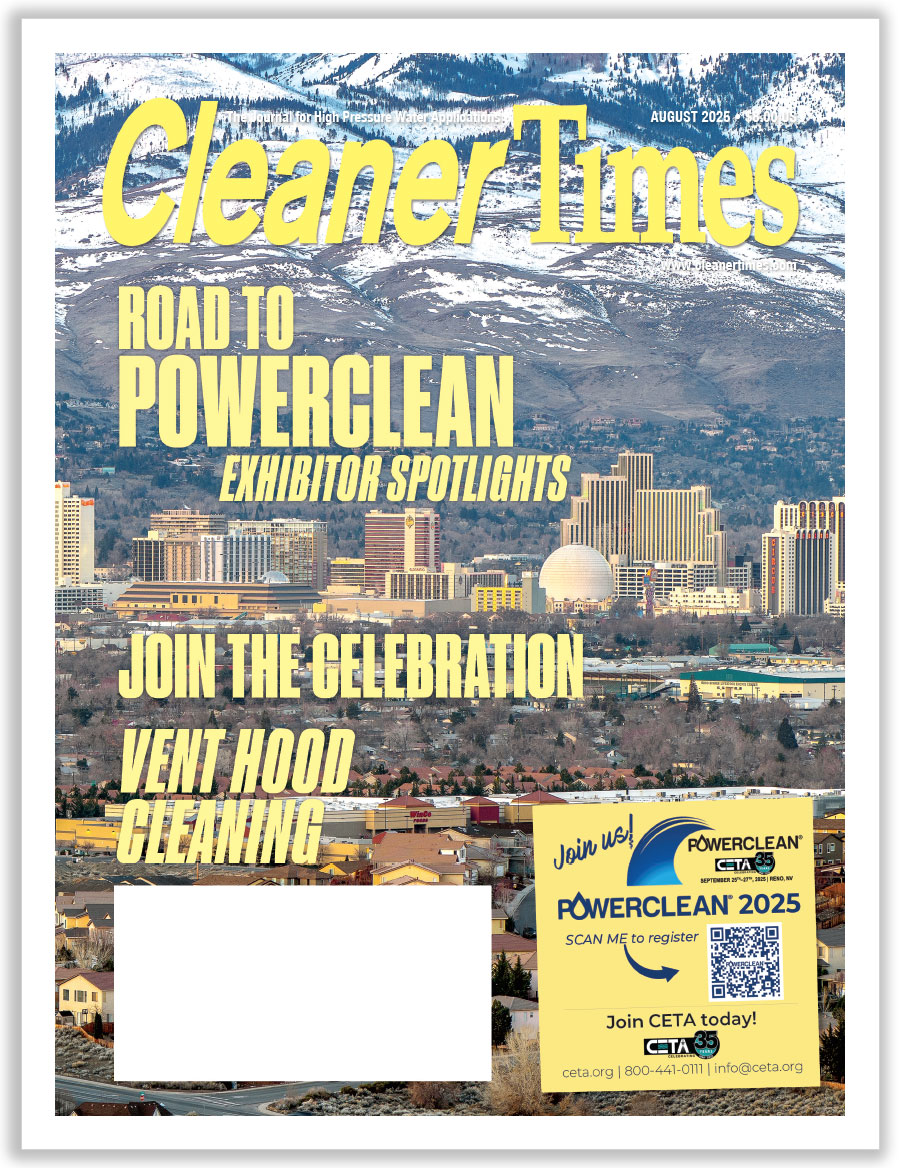
Industry Trends and New Developments
By Diane M. Calabrese / Published December 2020

Business as usual? Yes.
Inspired by their hands-on experience with pressure washers, practitioners have patent applications pending on everything from triggers that super-maximize operator control to attachments that eliminate grout for a very long time.
Invention, along with expansion, consolidation, competition, and regulation continue apace. Stasis? Perish the thought.
Begin with regulation. Some environmental regulations have been softened or eliminated under the current administration.
“I am not aware of additional environmental regulations as such, but how they are being enforced is changing,” says Robert M. Hinderliter, environmental consultant located in Burleson, TX. “The interpretation and enforcement components are subject to the political whims at the moment, as this can easily be done without public input or comment.”
The outcome of modification may be viewed as less restrictive or more permissive, depending on one’s vantage. “The major change I have seen is how pollution is measured and detected,” says Hinderliter, citing an example in regulations growing from the Clean Water Act of 1972.
“At the implementation of the CWA, pollution was detected in all of the MS4s (municipal separate storm sewer systems) of each particular jurisdiction,” explains Hinderliter.
“Now a lot of the detection has shifted to TMDL measurements,” says Hinderliter. (TMDL is the total maximum daily load of a pollutant.) “The TMDL is measured before the conveyance—river, stream, lake, etc.—enters the jurisdiction and after it exits the jurisdiction to measure the pollution load added…This does not require knowing where the pollution came from—except somewhere in the jurisdiction.”
Jurisdictions, of course, must continue to meet their biennial water quality reporting requirements to the Environmental Protection Agency (EPA). “The movement to TMDL was done at the requests of the municipalities because it is a lot less expensive than sampling all over the jurisdiction,” says Hinderliter. “Also, the state can now tell each jurisdiction exactly where and when each sample will be taken.”
The reporting allows for judgments to be made about the quality of water in states, tribal areas, and regions. It also informs the way in which the same entities construct plans to improve the quality of water.
The TMDL approach benefits contractors. “The pollution for power washing is insignificant when combined with all other pollutants from the jurisdiction,” says Hinderliter. “This means the enforcement is mainly by ‘compliant basis only’ for the power wash industry. I have had several state EPAs verify and acknowledge this.”
Voluntary compliance reduces some of the burden on contractors. The responsibility for properly handling wastewater is still present, though. Should laxity ever take hold within a state, tribal area, or region, the entity might take its own highly restrictive action to ensure that it can meet its requirements under the NPDES [National Pollutant Discharge Elimination System], which strives to keep POTWs [publicly owned water treatment works] free of pollutants.
In 2019 the EPA made changes to the Risk Management Plan (RMP) requirements for companies of all sizes if they use certain chemicals and retain them in large amounts. For example, chlorine exceeding 2,500 pounds requires an RMP, which must be submitted to the EPA. If in doubt regarding RMP requirements, check the compliance guide via https://www.epa.gov/sites/production/files/2013-10/documents/sb-final.pdf.
In October 2020, the EPA released the draft of a national recycling strategy. While thinking about reducing water and energy use and cutting emissions through innovation in design, manufacturers in our industry are also thinking about designing for easier recycling.
Competition (With Rules)
While EPA regulation has eased somewhat, determination to realize enforcement in other areas has increased. The U.S. Department of Commerce has been vigorous in its response to reports of unfair trade practices. In just the last few months, it has received and begun action on complaints about dumping practices by countries including China, Czechoslovakia, South Korea, and Russia.
Members of our industry have been among those filing petitions to ask Commerce to investigate. In August, Commerce made a preliminary determination that Chinese exporters of certain vertical shaft engines (between 99cc and 225cc) received as much as 21.29 percent in countervailing subsidies. Briggs and Stratton Corporation was the petitioner. (See Trade.gov, the web-site of Commerce’s International Trade Administration, ITA, for more examples.)
Assessment of just how extensive an issue dumping is led to recent initiatives like AIM (Aluminum Import Monitoring and Analysis Program) in April. It’s modeled on the Steel Import Monitoring and Analysis Program. The concept in both cases is to tie an import license to the importer’s commitment to reporting country of origin (e.g., where aluminum is smelted and poured), value, etc. so that evasion of duties can be detected and stopped.
Commerce is doing more than enforcement. It is also trying to remove barriers to US-made goods. Through its Market Development Cooperative Program (MDCP), the department wants to foster working relationships between the ITA and non-profit industry groups. Awardees in 2020 include the Association of Equipment Manufacturers, Milwaukee, WI. MDCP possibilities, should they continue, deserve exploration by associations in our industry.
Activity (and Assists)
Doing takes different forms. There’s expansion, reconfiguration, and pitching in when needed.
In August FNA Group, headquartered in Pleasant Prairie, WI, announced its expansion with a new location in Mesquite, TX. The Lone Star State 400,000-sq.-ft. facility, which will incorporate robotic technology to reduce waste and enhance throughput, becomes the company’s fifth U.S. manufacturing site. An employer roster of 300 is anticipated.
The aforementioned company also responded to the urgent needs of 2020 by introducing a sanitizing mister and pressure washing system (SM1200) suitable for settings ranging from schools and churches to hospitals and parks. The machine has a dual action valve that facilitates the switch between mister and pressure washer modes.
In September Briggs & Stratton, the world’s largest maker of gasoline engines, announced its sale to KPS Capital Partners. It will operate as an independent company following the sale with support of the buyer, a global private equity investor.
Putting its vast experience with engines (and the equipment they power, including pressure washers) to use, the aforementioned company also responded to the national crisis of 2020. It joined a group working on the development of face masks with filters that could be replaced and cleaned, tapping expertise gained from work with engine filters.
Harmonization (As Future)
On May 11, 2020, PHMSA (Pipeline and Hazardous Materials Safety Administration) in the U.S. Department of Transportation (DOT) issued the final rule on harmonization with international standards for hazardous materials. The voluntary compliance date for the rule was January 1, 2019. The delayed compliance date is May 10, 2021.
See the Federal Register entry for the final rule via https://www.federalregister.gov/documents/2020/05/11/2020-06205/hazardous-materials-harmonization-with-international-standards.
In making the modifications to the rule, PHMSA adopted many updated International Organization for Standardization (ISO) standards. Among the changes are those to the Hazardous Materials Table (HMT) that include additions, revisions, or removals involving shipping names, hazard classes, and so on. Another change involves a method for dealing with hazardous materials or residues that do not have a proper name (in the HMT).
Lithium batteries merit special concern in the final rule. Manufacturers must subject lithium batteries and cells to United Nations (UN) design tests to ensure required classification. Distributors of lithium batteries must be given test results by the manufacturers. Separation of lithium batteries from hazardous (largely flammable) substances during transport is also mandated.
There are many other changes in the final rule, including a delay to 2023 for criteria that deal with polymerizing chemicals.
The United States has been an active participant in the UN effort to adopt a Globally Harmonized System of Classification and Labelling of Chemicals (GHS) since the inception of the initiative in 2003. In 2009, the Occupational Safety and Health Administration (OSHA) committed to alignment of its Hazard Communication Standard (HCS) with GHS.
Interest in global harmonization extends to all parts of industry. It’s a trend that will continue. Another trend certain to continue is the requirement for licensure or some kind of practitioner certification.
Manufacturers in our industry already give attention to ergonomics when designing equipment. Rule makers in state and federal agencies want to increase safety at work sites by making the operation of equipment easier.
Design changes that make it more difficult to use a machine incorrectly as well as robotic assists that separate operator and machine will continue to be significant industry trends.
Recently Kärcher introduced a cordless floor cleaner. Eliminating cords is one of the surest ways to reduce trips and falls, a big concern of OSHA.
Anything is possible in the minds of inventors and dreamers. Will there ever be a machine that requires no hose (e.g., water generated in the machine)? It seems farfetched, but how many iron workers who once walked beams at perilous heights ever expected to be supplanted by a tower crane?
Working in an industrial setting—whether as manufacturer, distributor, or contractor, requires steadfastness. Reporting requirements alone require stamina. And we have only touched on a tiny fraction, not even getting to familiar expectations set by TSCA (Toxic Substances Control Act) and EPCRA (Emergency Planning and Community Right to Know).
But, strong participants make a strong industry.





